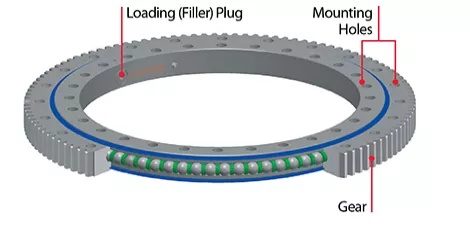Ring gears are typically manufactured through a process involving several key steps, including forging or casting, machining, hea
treatment, and finishing. Here’s an overview of the typical manufacturing process for ring gears:
Material Selection: The process begins with the selection of suitable materials for the ring gears based on the specific application
requirements. Common materials used for ring gears include various grades of steel, alloy steel, and even non-ferrous metals like bronze or
aluminum.
Forging or Casting: Depending on the material and production volume, ring gears may be manufactured through forging or casting
processes. Forging involves shaping heated metal billets under high pressure using forging dies to achieve the desired shape and
dimensions of the ring gear. Casting involves pouring molten metal into a mold cavity, allowing it to solidify and take the shape of the mold.
Machining: After forging or casting, the rough ring gear blank undergoes machining operations to achieve the final dimensions, tooth
profile, and surface finish. This may involve processes such as turning, milling, drilling, and gear cutting to form the teeth and other
features of the ring gear.
Heat Treatment: Once machined to the desired shape, the ring gears typically undergo heat treatment to improve their mechanical
properties, such as hardness, strength, and toughness. Common heat treatment processes for ring gears include carburizing, quenching,
and tempering to achieve the desired combination of properties.Gear Cutting: In this step, the tooth profile of the ring gear is cut or shaped
using specialized gear cutting machines. Common methods include hobbing, shaping, or milling, depending on the specific requirements of
the gear design.
Quality Control: Throughout the manufacturing process, rigorous quality control measures are implemented to ensure that the ring gears
meet the required specifications and standards. This may involve dimensional inspection, material testing, and non-destructive testing
methods such as ultrasonic testing or magnetic particle inspection.
Finishing Operations: After heat treatment and gear cutting, the ring gears may undergo additional finishing operations to improve surface
finish and dimensionalaccuracy. This may include grinding, honing, or lapping to achieve the final surface quality required for the specific
application.
Final Inspection and Packaging: Once all manufacturing and finishing operations are complete, the finished ring gears undergo final
inspection to verify their quality and conformance to specifications. After inspection, the ring gears are typically packaged and prepared for
shipment to customers or assembly into larger gear assemblies or systems.
Overall, the manufacturing process forring gearsinvolves a combination of forging or casting, machining, heat treatment, and finishing
operations to produce high-quality components suitable for various industrial applications. Each step in the process requires careful
attention to detail and precision to ensure the final products meet the required standards for performance and reliability.
Post time: Jun-14-2024






